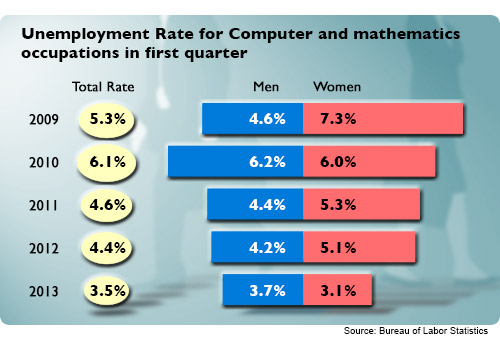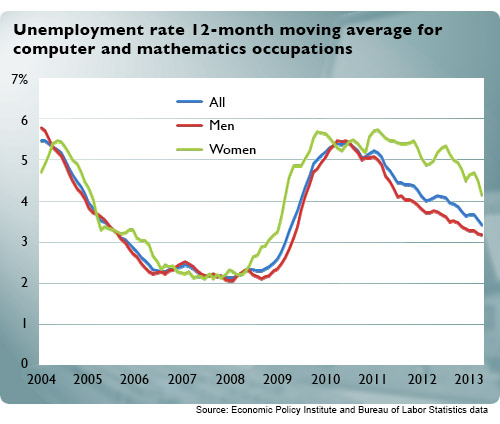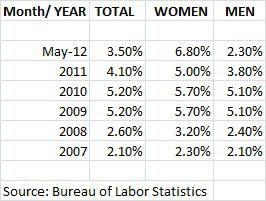The gap in the unemployment rates for women and men in technology showed signs of narrowing during the first quarter: The unemployment rate for women in computer and mathematical occupations fell to 3.1 percent, compared with 3.7 percent for men, according to the Bureau of Labor Statistics.

But this seems to be more than a one-quarter thing. A 12-month moving average of unemployment rates between women and men in IT from the Economic Policy Institute shows the gender gap narrowing over the past nine months. "The unemployment rate for men improved sooner than women, post-recession," says Heidi Shierholz, an EPI economist. "Women didn't improve as much for a couple of years, so the gap widened. But over the past nine months, it has improved for women, so it appears the gap is closing."

Shierholz cautions, however, that the sample pool for the sector's women is much smaller than men's, so there is greater volatility in the results.
Why the Tightening?
Over the past several years, companies have become particularly interested in attracting and retaining women IT workers, observes Carolyn Leighton, founder and chairwoman of Women in Technology International, popularly known as WITI. "There's a greater awareness over the last two or three years. We see more companies reaching out to us and calling us to partner with WITI, whereas 10 years ago we were always calling companies," she says. That shift toward a corporate desire to hire and retain women in the IT workforce undoubtedly plays a role in narrowing the gap. Companies are increasingly seeking women technologists as siloed IT departments give way to organizations that touch a number of departments spread across the enterprise. "Originally, if you were an IT programmer and didn't want to communicate with anyone, that worked. But now, people are not just great programmers but also need to be great communicators to the sales department and other departments within the business," Leighton notes. "They have to feel comfortable working with others and companies are starting to recognize the ability of women to collaborate, communicate and build consensus." Shierholz doesn't entirely agree. While she says the way companies perceive women in IT has likely changed over the years, she questions if that's what's driving the shrinking gap in the unemployment numbers. "I don't think it explains why women's unemployment rates have come down so fast in the past nine months and why it rose faster than men's during the recession," she says. "I think it's a reflection of how companies are coping in the aftermath of the recession, rather than being driven by broad structural changes." However, she believes those broad structural changes may have tempered the depth of the unemployment rate for women in technology. "Twenty years ago, the unemployment rate for women may have risen faster," Shierholz says.
 Shierholz cautions, however, that the sample pool for the sector's women is much smaller than men's, so there is greater volatility in the results.
Shierholz cautions, however, that the sample pool for the sector's women is much smaller than men's, so there is greater volatility in the results.
 Shierholz cautions, however, that the sample pool for the sector's women is much smaller than men's, so there is greater volatility in the results.
Shierholz cautions, however, that the sample pool for the sector's women is much smaller than men's, so there is greater volatility in the results.
 Shierholz cautions, however, that the sample pool for the sector's women is much smaller than men's, so there is greater volatility in the results.
Shierholz cautions, however, that the sample pool for the sector's women is much smaller than men's, so there is greater volatility in the results.


![Go to article IT Women See Unemployment Gap Widen [DiceTV]](/binaries/small/content/gallery/dice/insights/2012/07/dicetv-unemployment.jpg)

